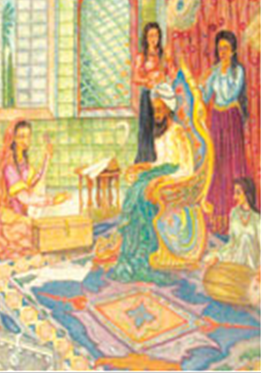Haji Abdul Malik Khan
This is a collection of articles archived for the excellence of their content. Readers will be able to edit existing articles and post new articles directly |
Haji Abdul Malik Khan
Bridging Time
By Bibigul
Eighty-five years old artist, Haji Abdul Malik Khan recently had a retrospective exhibition of his work at the Alhamra Galleries in Lahore. A student of Ustad Allah Bakhsh, the veteran artist’s exhibition comprised some 100 pieces of his artwork belonging mostly to the mid-twentieth century — the subjects varying from realistic rendering of landscapes preferably with romantic overtures that are mildly reminiscent of the works of William Blake to rustic folkloric fables.
In the landscapes, there are no tell-tale signs of progress but according to him this is a deliberate statement he is making. While faces lurk behind rocks, concealed within the nooks and crannies of a virgin land, he uses strong lines in pen and ink to draw the righteous, the unrelenting mountains and the studies of flora. Haji is not open to discussion; he is adamant in his appraisal of the unseen.
‘Murree scene’ and ‘Hill station’ depict homes nestled in the mountains which emerge as an accurate account of the land with its ecology, at the same time acknowledging the supremacy of nature which is much too powerful to be dominated by man. Facial expressions of the figure compositions of ‘Sohni Mahinwal’ and ‘Heer’ show feelings; the characters are caught in a ‘stage performance’ as if under the spotlight and look back at the audience to see their response. Individual portraits also make an appearance and are communicative displaying, meticulous observations. The compositions of rural scenes establish the rural lifestyle and show the interiors of rural homes.
Also included in the exhibition were posters of Indian films which attracted almost all the viewers. Except for one, which is a block print made for the Pakistan Times, the rest are lithograph prints that have portraits of famous film stars, with no violent action or suggestion of it.
Some of the paintings are grouped together, while others are painstakingly identified as ‘Souls from earth to heaven’, ‘Flowing river’, ‘Tree with shapes’, etc. The exhibition shows a complete picture of art ‘requirements’ of the ’40s and ’50s. The sizes of the paintings are small compared to the larger sizes preferred by contemporary artists; most of them are one-and-a-half feet by two-and-a-half feet. The frames are narrow and in a large variety of locally-made engraved designs and colours. The media used are oil on canvas, watercolour, colour pencils, chalk, pastels or pen and ink on paper, and the prices are comfortably affordable.
Haji’s daughter Kaukab, who oraganised the exhibition says that her father had a penchant for drawing and painting since he was a child and her grandfather left him with Ustad Allah Bakhsh in Lahore where he lived, studied, grew up, got married and remained till the Ustad’s death. It was then that he and his wife moved to their own house and raised a family.
Haji worked with the Pakistan Times, the Shahnoor studios as a set designer and then with Packages, as a colour separatist — a function in picture reproduction, which was at its height at the time.
The display of Haji’s work was a visualisation of one phase of artwork from the ’50s. It would be interesting to study where this particular line of creativity stands today.
